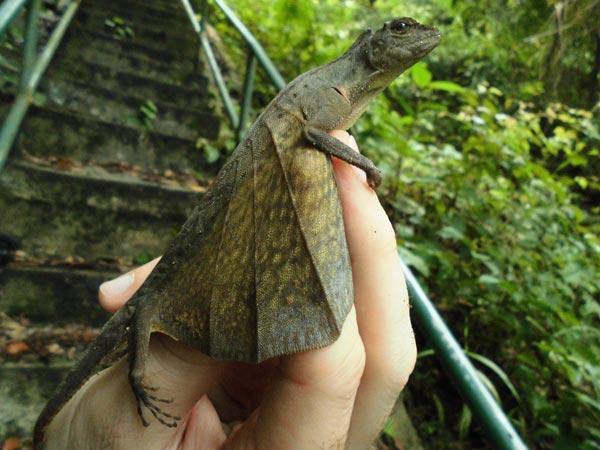
Credit: Terry Ord
A study of gliding animals has challenged the idea that evolutionary innovations – adaptations that bring new abilities and advantages – spur the origin of other new body types and other characteristics in descendent species. The research, undertaken by evolutionary biologists at UNSW Sydney and universities in the US and Spain, examined the key innovation of gliding in two types of gliding animals: ‘flying’ dragons (family Agamidae) and ‘flying’ squirrels (family Sciuridae), both common to forests in Southeast Asia. “Gliding Dragons and Flying Squirrels: Diversifying versus Stabilizing Selection on Morphology following the Evolution of an Innovation,” published in The American Naturalist 195, no. 2 (February 2020), confirms previous assumptions that gliding animals originated from arboreal ancestors and likely arose as a means of escaping predators some 25-30 million years ago.
Lead author Dr. Terry Ord, an evolutionary ecologist with UNSW’s Evolution & Ecology Research Centre, says another advantage that gliding brought was the ability to exploit a new three dimensional environment and explore more of the forest than just one tree. “From an evolutionary biologist’s perspective, these types of innovation that open up new opportunities are assumed to drive even more adapted diversification,” Dr. Ord says. “Suddenly there’s all these new microhabitats available offering up new resources and you have new species moving into those particular microhabitats where you would expect them to adapt even more.”
The evolution of flight in birds, insects and bats is an example where the changes brought about by ‘taking to the wing’ caused an explosion in diversity. Millions of species of insects, tens of thousands of birds and more than a thousand species of bats developed greatly different shapes, sizes, behaviors and habitats since their ancestors first evolved to fly. But in the case of the gliding animals like the dragons and squirrels, the advantage of gliding has not led to a proliferation of changes to body shapes, sizes and functions. In fact, for the dragons the key innovation of gliding appears to have done the opposite. “In the case of the dragon lizards, gliding appears to be a constraint on subsequent adaptation because of the aerodynamics of having to glide,” Dr. Ord says. “Basically the heavier you are, the more difficult it is to glide. So there is a constraint on general body size and shape – meaning a halt to the evolution of longer limbs and bigger heads, for example, that would normally reflect adaptation to particular microhabitats. But instead, the dragons have to glide, and that means limiting their body sizes to stay small and aerodynamic – which has what we call stabilizing selection on their bodies.”
Interestingly, some species of flying dragons actually did go on to evolve larger bodies, at the expense of their gliding abilities. To offset their poor gliding, they had to develop new behaviors such as flattening their bodies against the tree trunk to blend in with the bark, Dr. Ord says. “So they’re almost regressing from that gliding lifestyle. But in this case, the reason why they’re changing their body size is to overcome competition with other lizards.” There were no such bodily constraints with squirrels, due to key differences in the gliding membranes. Whereas the ribs of the dragon lizards evolved to extend laterally as the ‘wings’ of the animals, the squirrels’ gliding membrane developed as a flap of skin joining their wrists to their ankles. “So squirrels just evolve longer limbs which means the size of the membrane increases proportionally to the longer limbs, enabling somewhat bigger bodied animals to glide without sacrificing too much ability,” says Dr. Ord. But despite squirrel body sizes not being as constrained, the body sizes and characteristics of gliding squirrels are no more diverse than non-gliding squirrels. “So again the expectation of a key innovation driving the evolution of greater diversity was thwarted in the case of gliding squirrels.”
Dr. Ord says his research has implications for our understanding of the way key innovations and competition come into play in evolution. “Evolutionary innovations are evocative because they’re often amazing curiosities. And perhaps this has led us to infer they’re also key in opening the door to even more adaptation. But it seems that interactions with other organisms – competition for resources – is a far more powerful force for generating adaptive diversity,” he says. Looking ahead, Dr. Ord will be following up with research into the dragon lizards to find out how they use another evolutionary innovation, their dewlaps – the colorful flap of skin that hangs beneath their jaws – to communicate.
###
Media Contact
Mallory Gevaert
[email protected]
773-834-5192
Original Source
https:/




